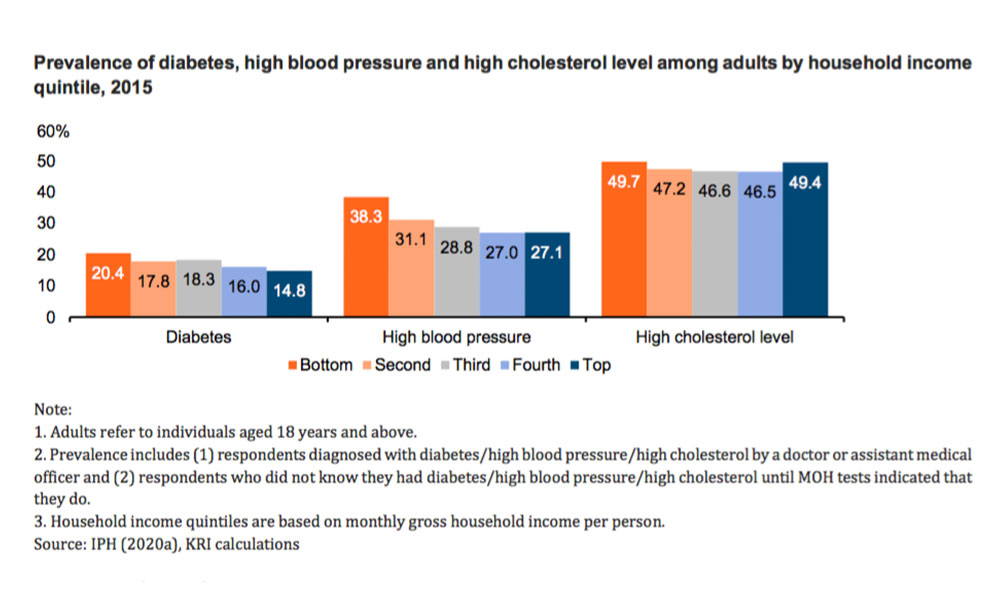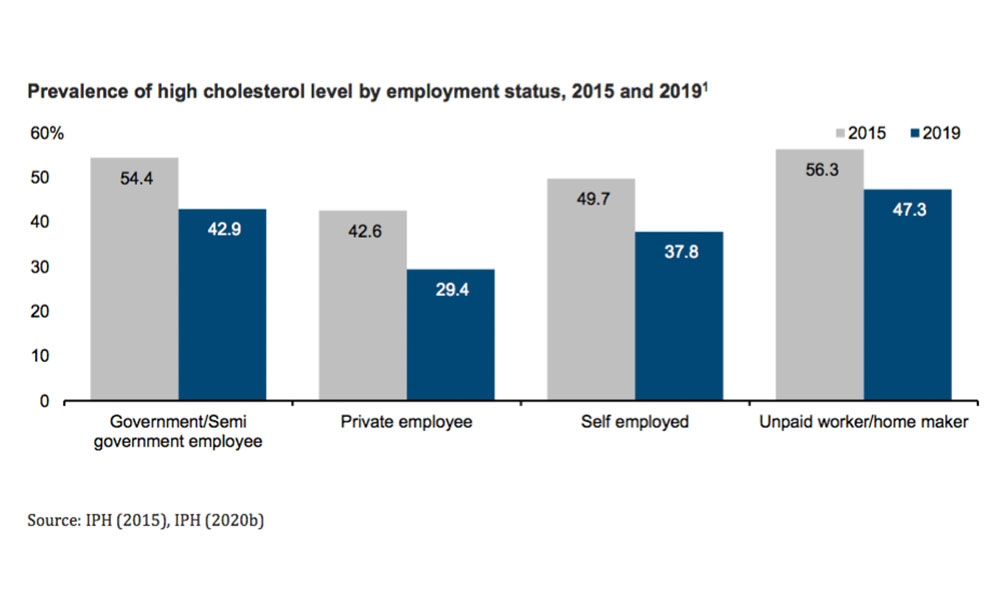A study has found a correlation between household income and health outcomes, with adults in lower-income groups reporting a higher prevalence of chronic diseases and mental health issues.
Published by Khazanah Research Institute (KRI) today, the research also found that unpaid workers like homemakers recorded the highest prevalence of such conditions.
Using 2015 numbers, adults in the lowest household income category reported the highest numbers of high blood pressure, diabetes and high cholesterol when compared to adults in higher-income groups.
The biggest chasm was observed in high blood pressure data.
Some 38.3 percent of adults from the lowest household income group had the condition compared to 27.1 percent of adults in the highest income group. This marked a 11.2 percent difference.

When researchers zoomed into the health of adults across different employment statuses in 2019, unpaid workers like homemakers recorded the highest prevalence of diabetes, high blood pressure and cholesterol.
In contrast, those working in the private sector recorded the lowest prevalence of such diseases.
Almost half of all unpaid workers (47.3 percent) were reported to suffer from high cholesterol compared to 29.4 percent of private-sector employees.

Mental health
The Social Inequalities and Health Malaysia study, the third instalment of KRI’s The State of Households 2020 presentations, also found similar trends in mental health data.
In both adults and children, those from the lowest income category recorded the highest incidences of mental health issues.

Mental health issues were recorded in 33.6 percent of adults from the lowest household income group compared to 26.4 percent of adults in the highest income group. This is a 7.2 percent difference.
Again, adults in unpaid or household work recorded the highest prevalence of mental health issues. The difference was far more marginal compared to chronic diseases.
The most prevalent mental health issues in Malaysia by far are anxiety and depression.

Among children, 13.9 of those from the lowest-income households said they experienced mental health issues compared to 8.0 percent in the highest-income households. This is a 5.9 percent difference.
Further study showed that children from the lowest income households struggle most with “peer problems” (bullying and isolation), personal conduct issues (cheating and lying) and “emotional” issues (unhappiness and worry).
Invest in preventive healthcare
Authored by researchers Nazihah Mohamad Noor, Jarud Romadan Khalidi and Puteri Marjan Megat Muzafar, the report noted the links between social inequalities and health outcomes.
They also noted adults in lower-income groups were more likely to smoke and binge drink while those in higher-income groups were more likely to eat enough fruits and vegetables.

“Available statistics for Malaysia suggest that in general, the most socially disadvantaged members of society are the ones who experience more detrimental exposure and greater vulnerability to health-damaging factors,” they said.
They were further concerned about the medical issues among many unpaid workers and homemakers because this group was more likely not to have any medical coverage.
“(They are) less likely to use medical insurance compared to private sector employees to pay for healthcare, meaning they are more likely to rely on out-of-pocket payments.
“This also suggests that unpaid workers and homemakers are more dependent on unstable financial sources to pay for care, influencing their decision to seek care and subsequently contributing to unequal health outcomes,“ they analysed.
The researchers thus urged policymakers to take social inequalities into greater account when deciding on healthcare.
“Health policy must take a longer-term, preventive approach to address the root causes of health challenges, going beyond curative care,” they also proposed.
In 2018, they calculated that a much larger chunk of healthcare expenditure (68.3 percent) was spent on curative care compared to the mere 6.1 percent spent on preventive services. - Mkini




No comments:
Post a Comment
Note: Only a member of this blog may post a comment.